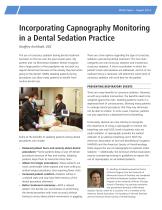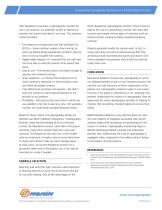 Website:
Nonin
Website:
Nonin
Catalog excerpts

White Paper • August 2014 Geoffrey Archibald, DDS The use of conscious sedation during dental treatment has been on the rise over the past several years. My partner and I at Minnesota Sedation Dental recognize that a large portion of the population do not seek out regular dental care because of the anxiety they feel when going to the dentist. Mildly sedating patients during procedures can allow many patients to benefit from routine dental care. Some of the benefits of sedating patients during dental procedures can include: • Reduced patient fears and anxiety about dental procedures—Some patients delay or put off dental procedures because of fear and anxiety. Sedating patients helps them to overcome those fears. • Allows for longer procedures—Many patients are more comfortable while sedated and more willing to endure longer procedures, thus requiring fewer visits. • Increased patient comfort—Patients will be in a relaxed state and may have little memory of the dental procedure afterward. • Better treatment outcomes—With a relaxed patient, the dentist can concentrate on performing the dental procedure with more accuracy without having to worry about patient movements or gagging. There are a few options regarding the type of conscious sedation used during dental treatment. The two main categories are oral conscious sedation and intravenous conscious sedation. A short consultation in which the patient's fears and anxieties are addressed, and his or her medical history is reviewed, will determine which level of conscious sedation will work best for the patient. PREVENTING RESPIRATORY EVENTS There are many benefits to conscious sedation. However, as with any medical intervention, the benefits need to be weighed against the risks. Sedating patients results in a depressed level of consciousness, allowing many patients to undergo dental procedures that they may otherwise not be able to endure. In some cases, however, patients can also experience a depressed level of breathing. Fortunately, dentists are now starting to recognize the importance of using a capnograph to monitor the breathing rate and EtCO2 levels of patients who are under sedation. A capnograph provides the earliest indicator of an adverse breathing event. Both the American Association of Oral and Maxillofacial Surgeons (AAOMS) and the American Society of Anesthesiology (ASA) require the use of capnography for patients under sedation.1'2 Additionally, the American Dental Association may be considering revising its guidelines to require the use of capnography on all sedated patients. Dr. Geoffrey Archibald received his Doctor of Dental Surgery from the University of Minnesota-School of Dentistry and completed the Mild and Moderate Sedation Provider Program at the University of Illinois Chicago-School of Dentistry. He practices restorative and preventative dentistry at Minnesota Sedation Dental, where he is a partner. He is a member of the American Dental Association, the Academy of General Dentistry and the American Dental Society of Anesthesiology.
Open the catalog to page 1
Incorporating Capnography Monitoring in a Dental Sedation Practice After deciding to purchase a capnography monitor for use in our practice, my attention turned to selecting a monitor that would work best in our clinic. The selection criteria included: • Fast detection of respiratory rate and end-tidal CO2 (EtCO2)—Some monitors require a few minutes to warm up before being operational; we didn’t want to have to eat up valuable time waiting. • Highly visible display—It’s important for my staff and me to be able to read the monitor from several feet away. • Easy to use—The monitor had to be...
Open the catalog to page 2All Nonin catalogs and technical brochures
-
SenSmart® 8006 Hybrid Sensor
2 Pages
-
WristOx2 ® Model 3150 USB
2 Pages
-
Unmatched Pulse Oximetry
2 Pages
-
NoninConnect Elite 3240
4 Pages
-
8204CA
4 Pages
-
8000 series
2 Pages
-
Narcotrend Compact-M
2 Pages
-
Unmatched Pulse Oximetry
2 Pages
-
9840/8500 Series
1 Pages
-
Onyx III 9591
2 Pages
-
6000 C series
2 Pages
-
USB-Desaturation
1 Pages
-
Capnography-for-CPR.
2 Pages
-
Nonin3230-3231
4 Pages
-
PalmSAT 2500 Brochure
2 Pages
-
Capnography Pain Management
2 Pages
-
CapnographyEMSTransport
2 Pages
-
RespSense
2 Pages
-
Why Nonin Sensors
4 Pages
-
PureSAT Advantage
2 Pages
-
Product Catalog
21 Pages
-
Avant 2120
2 Pages
-
Model 7500 Series
2 Pages
-
PureLight Sensors Brochure
2 Pages
-
3150 Sleep Flyer
2 Pages
-
LifeSense VET Brochure
2 Pages
-
Nonin Onyx Brochure
6 Pages
-
LifeSense®
2 Pages
-
9840 Series
2 Pages
-
WristOx 3100 Brochure
2 Pages
-
ipod Specifications
6 Pages
-
WIDESCREEN Pulse Oximeter
2 Pages
-
Vet Family Brochure
4 Pages
-
System Story Brochure
2 Pages
-
OEM Xpod Brochure
2 Pages
-
Avant® 9600
2 Pages
-
Onyx II, Model 9560 Brochure
3 Pages
-
Avant® 9700
2 Pages
-
Model 8500 Series
2 Pages
-
Capnography Use in Homecare
2 Pages
-
EQUANOX?, Model 7600
2 Pages
-
Flexi-Form ® III 7000 Series
2 Pages
-
Cloth 6000C Series
2 Pages
-
Onyx Vantage 9590
2 Pages
-
Dr Petty GO2 Brochure
13 Pages
-
nVision
4 Pages
-
2500A VET Spec Sheet
2 Pages
-
PulseSense VET Brochure
2 Pages
-
RespSense VET Brochure
2 Pages
-
9847V Brochure
2 Pages
-
Model 8500AV Brochure
2 Pages
-
3150 Ambulatory Flyer
2 Pages
-
LifeSense®
2 Pages
-
WristOx2?
2 Pages
-
Model 7500
4 Pages
-
SpO2 Disposable Sensors
4 Pages
-
9500 Spec Sheet
2 Pages
-
Onyx® II 9550
2 Pages
-
Onyx9550
4 Pages
Archived catalogs
-
System Story Brochure Old
4 Pages
-
Vet Family Brochure Old
4 Pages
-
LifeSense® Old
2 Pages
-
Avant® 9600
1 Pages
-
Onyx® II, Model 9560
4 Pages
-
Product catalog
21 Pages

















































































